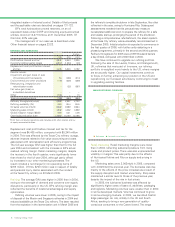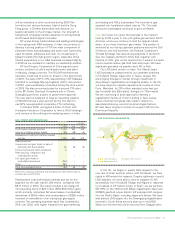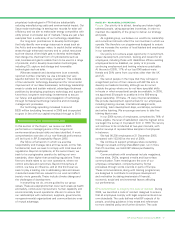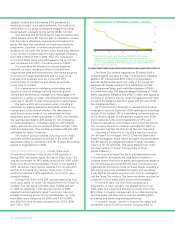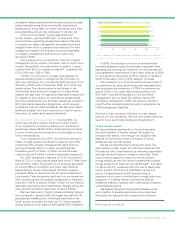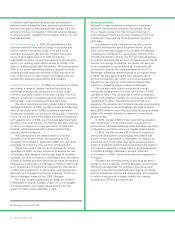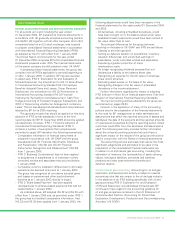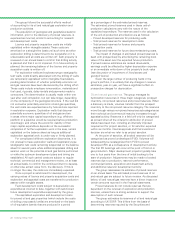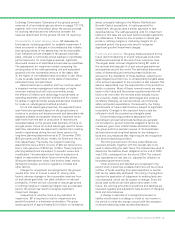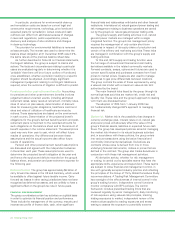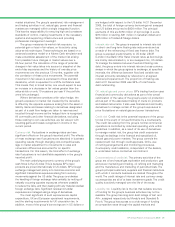BP 2005 Annual Report Download - page 26
Download and view the complete annual report
Please find page 26 of the 2005 BP annual report below. You can navigate through the pages in the report by either clicking on the pages listed below, or by using the keyword search tool below to find specific information within the annual report.
24 Making energy more
In particular, provisions for environmental clean-up
and remediation costs are based on current legal and
constructive requirements, technology, price levels and
expected plans for remediation. Actual costs and cash
outflows can differ from estimates because of changes
in laws and regulations, public expectations, prices,
discovery and analysis of site conditions and changes
in clean-up technology.
The provision for environmental liabilities is reviewed
at least annually. The interest rate used to determine the
balance sheet obligation at 31 December 2005 was 2.0%,
the same rate as at the previous balance sheet date.
As further described in Note 48 on financial statements,
Contingent liabilities, the group is subject to claims and
actions. The facts and circumstances relating to particular
cases are evaluated regularly in determining whether it is
‘probable’ that there will be a future outflow of funds and,
once established, whether a provision relating to a specific
litigation should be adjusted. Accordingly, significant
management judgement relating to contingent liabilities is
required, since the outcome of litigation is difficult to predict.
Pensions and other post-retirement benefits Accounting
for pensions and other post-retirement benefits involves
judgement about uncertain events, including estimated
retirement dates, salary levels at retirement, mortality rates,
rates of return on plan assets, determination of discount
rates for measuring plan obligations, healthcare cost-trend
rates and rates of utilization of healthcare services by
retirees. These assumptions are based on the environment
in each country. Determination of the projected benefit
obligations for the group’s defined benefit pension and post-
retirement plans is important to the recorded amounts for
such obligations on the balance sheet and to the amount of
benefit expense in the income statement. The assumptions
used may vary from year to year, which will affect future
results of operations. Any differences between these
assumptions and the actual outcome also affect future
results of operations.
Pension and other post-retirement benefit assumptions
are discussed and agreed with the independent actuaries
in December each year. These assumptions are used to
determine the projected benefit obligation at the year end
and hence the surplus and deficits recorded on the group’s
balance sheet, and pension and post-retirement expense for
the following year.
Deferred taxation The group has approximately $5 billion of
carry forward tax losses in the UK and Germany, which would
be available to offset against future taxable income. Carry
forward tax losses in other taxing jurisdictions have not been
recognized as deferred tax assets, and are unlikely to have a
significant effect on the group’s tax rate in future years.
FINANCIAL RISK MANAGEMENT
The group co-ordinates certain key activities on a global basis
in order to optimize its financial position and performance.
These include the management of the currency, maturity and
interest rate profile of finance debt, cash, other significant
financial risks and relationships with banks and other financial
institutions. International oil, natural gas and power trading and
risk management relating to business operations are carried
out by the group’s oil, natural gas and power trading units.
The group’s supply and trading activities in oil, natural
gas and power markets are managed within a single
integrated function. The group’s risk management policy
requires the management of only certain short-term
exposures in respect of its equity share of production and
certain of its refinery and marketing activities. These risks
are managed in combination with the group’s supply and
trading activities.
To this end, BP’s supply and trading function uses
the full range of conventional financial and commodity
derivatives available in the related commodity markets.
Forward contracts, swaps, options and futures are used to
convert specific sales and purchases contracts from fixed
prices to market prices. Swaps are also used to manage
exposures to gas price differentials between locations.
The group controls the scale of these exposures by using
a value-at-risk model with a maximum value-at-risk limit
authorized by the board.
The main financial risks faced by the group through its
normal business activities are market risk, credit risk and
liquidity risk. These risks and the group’s approach to dealing
with them are discussed below.
The adoption of IFRS from 1 January 2005 has
not fundamentally changed BP’s approach to managing
financial risk.
Market risk Market risk is the possibility that changes in
currency exchange rates, interest rates or oil, natural gas
and power prices will adversely affect the value of the
group’s financial assets, liabilities or expected future cash
flows. The group has developed policies aimed at managing
the market risk inherent in its natural business activities
and, in accordance with these policies, the group enters
into various transactions using derivative financial and
commodity instruments (derivatives). Derivatives are
contracts whose value is derived from one or more
underlying financial instruments, indices or prices that are
defined in the contract. The group also trades derivatives in
conjunction with these risk management activities.
All derivative activity, whether for risk management
or trading, is carried out by specialist teams that have the
appropriate skills, experience and supervision. These teams
are subject to close financial and management control, in
line with generally accepted industry practice and reflecting
the principles of the Group of Thirty Global Derivatives Study
recommendations. A Trading Risk Management Committee
has oversight of the effectiveness of internal control in the
group’s trading function. Independent control functions
monitor compliance with BP’s policies. The control
framework includes prescribed trading limits that are
reviewed regularly by senior management, daily monitoring
of risk exposure using value-at-risk principles, marking
trading exposures to market, independent review of the
market values applied to trading exposures and stress
testing to assess the exposure to potentially extreme


